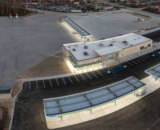Welcome to the newest post in our blog series, Top 20 ADA Compliance Issues Seen in Truckstops and Travel Plazas. Join guest post by contributor Brad Gaskins, The McIntosh Group on the second Friday of every month for his monthly column.
/// Guest post by contributor Brad Gaskins, The McIntosh Group
We continue our series on the top 20 Americans with Disabilities Act (ADA) compliance issues seen in truck stops and travel plazas by discussing curb ramps. Are your curb ramps compliant?
I’ll break down the requirements and list the corresponding section numbers found in The 2010 ADA Standards for Accessible Design.
We’ll start by defining a ramp. An accessible route1 can have a maximum slope of 5%; if greater than 5% it’s considered a ramp.
The Standards list the following requirements for curb ramps:
- The running slope2 of a curb ramp shouldn’t be steeper than 8.33% (405.2)
- The clear width of a curb ramp should be a minimum of 36 inches (405.5)
- Where provided, curb ramp flares shouldn’t be steeper than 10% (406.3)
Landings should be provided at the tops of curb ramps and have the following requirements:
- The landing length should be a minimum of 36 inches (406.4)
- The landing width should also be a minimum of 36 inches, and be at least the width of the curb ramp, excluding flared sides, leading to the landing (406.4)
- Slopes less than 2%, in all directions, are permitted
- Landings subject to wet conditions should be designed to prevent the accumulation of water (405.10)
The 2010 Standards state that counter slopes of adjoining gutters and road surfaces immediately adjacent to the curb ramp shouldn’t be steeper than 5%. The adjacent surfaces at transitions at curb ramps to walks, gutters and streets should be at the same level (406.2). The second sentence here is better explained with the language from the 1991 Standards, “Transitions from ramps to walks, gutters, or streets shall be flush and free of abrupt changes.”
Location of the curb ramp and flared sides must be located that do not project into vehicular traffic lanes, parking spaces or parking access aisles (406.5). I’ve included an example of where NOT to place a curb ramp.
I would advise you to pay special attention to curb ramp location in respect to the entry. This is because poor placement can increase the incident of slips and falls. I believe a bad location is a curb ramp located directly in front of door. It is best to off-set the ramp from door.
I hope you check back next month as I continue this series. We’ll cover another of the compliance issues seen in truck stops and travel plazas, thresholds that are too high at front entry doors.
1 An accessible route is a continuous, unobstructed path connecting all accessible elements and spaces of a building or facility that meets the requirements of ADA Standards.
2 Running slope is the slope that is parallel to the direction of travel.
Subscribe to Updates
NATSO provides a breadth of information created to strengthen travel plazas’ ability to meet the needs of the travelling public in an age of disruption. This includes knowledge filled blog posts, articles and publications. If you would like to receive a digest of blog post and articles directly in your inbox, please provide your name, email and the frequency of the updates you want to receive the email digest.


